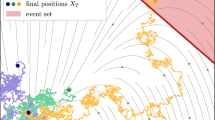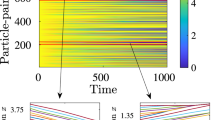Abstract
A scheme of decimation, or statistical interpolation, is developed for stochastic systems which exhibit dynamical and statistical symmetries among groups of modes. The end product is generalized Langevin equations for a sample set of explicitly followed modes. All the other modes are represented by the random forcing amplitudes in the Langevin equations. The random forcing is constrained by realizability inequalities and by appeal to the statistical symmetries. The latter yield expressions for moments of the joint probability distribution of forcing amplitudes and sample-set amplitudes in terms of moments of the sample-set amplitudes alone. This permits integration of the dynamical equations for an ensemble of sample-set amplitudes. Converging approximation sequences may be generated by systematically enlarging the set of constraints.
The decimation scheme (DS) bridges among several kinds of attack on the turbulence problem: moment hierarchy equations, renormalized perturbation theory (RPT), renormalization group methods, and direct modeling of large systems by systems with fewer modes. The DS does not appeal to perturbation theory, but in the limit of strong decimation it can be analyzed perturbatively. The direct-interaction approximation and other RPT approximations may thereby be obtained from appropriate moment constraints. One feature of the DS is that invariance to random Galilean transformation, a severe problem in the RPT treatment of turbulence, can be directly assured by constraints which relate 3rd-and 4th-order moments.
Access this chapter
Tax calculation will be finalised at checkout
Purchases are for personal use only
Preview
Unable to display preview. Download preview PDF.
Similar content being viewed by others
References
M.Van Dyke, An Album of Fluid Motion (Parabolic, Stanford, 1982), Chs. 5 & 6.
H. S. Wall, Analytical Theory of Continued Fractions (Chelsea, New York, 1967), p. 330.
R. H. Kraichnan, Adv. Math. 16, 305 (1975).
R. H. Kraichnan, J. Math. Phys. 2, 124 (1961); 3, 205 (1962).
R. H. Kraichnan, J. Fluid Mech. 41, 189 (1970).
C. Lanczos, Applied Analysis (Prentice Hall, Englewood Cliffs, New Jersey, 1956), p. 376.
R. H. Kraichnan, Phys. Rev. Lett. 42, 1263 (1979).
G. H. Hardy, J. E. Littlewood, G. Pólya, Inequalities (Cambridge University Press, Cambridge, England, 1967), p. 56.
R. H. Kraichnan, in Nonlinear Dynamics, edited by H.G. Heileman (New York Academy of Sciences, New York, 1980), p. 37.
Hut not always. For example, the two constraints ‹x› = 1, ‹x2› = 1 force x = 1 in all realizations for any finite R.
An example of realization of a velocity field with prescribed covariance is given by R. H. Kraichnan, Phys. Fluids 13, 22 (1970).
R.H. Kraichnan, J. Fluid Mech. 83, 349 (1977).
C.E. Leith, J. Atoros. Sci. 28, 145 (1971).
R.H. Kraichnan, Phys. Fluids 11, 1723 (1964).
P.C. Martin, E. D. Siggia & H. A. Rose, Phys. Rev. A 8, 423 (1973).
R. Phythian, J. Phys. A 8, 1423 (1975); 9, 269 (1976).
S. A. Orszag & R. H. Kraichnan, Phys. Fluids 10, 1720 (1967).
J. R. Herring & R. H. Kraichnan, in Statistical Models and Turbulence, edited by M. Rosenblatt and C. Van Atta(Springer-Verlag, New York, 1972)
R. H. Kraichnan in The Padé Approximant in Theoretical Physics, edited by G. A. Baker, Jr. and J. L. Gammel (Academic Press, New York, 1970), Ch. 4, Sec. V. The P defined in this ref. is n in the present notation.
In the notation of Ref. 4, Schwarz inequalities show that, if C2;1 = 1 and C4;3 = 1, then infinite classes of cycles not reducible to these cycles by vertex contraction also have the value unity. In particular, the cycles represented by the diagrams of Ref. 4, Fig. 8(c) have this value.
H. A. Rose, private communication.
Editor information
Editors and Affiliations
Rights and permissions
Copyright information
© 1985 Springer Science+Business Media New York
About this chapter
Cite this chapter
Kraichnan, R.H. (1985). Decimated Amplitude Equations in Turbulence Dynamics. In: Dwoyer, D.L., Hussaini, M.Y., Voigt, R.G. (eds) Theoretical Approaches to Turbulence. Applied Mathematical Sciences, vol 58. Springer, New York, NY. https://doi.org/10.1007/978-1-4612-1092-4_5
Download citation
DOI: https://doi.org/10.1007/978-1-4612-1092-4_5
Publisher Name: Springer, New York, NY
Print ISBN: 978-0-387-96191-0
Online ISBN: 978-1-4612-1092-4
eBook Packages: Springer Book Archive




